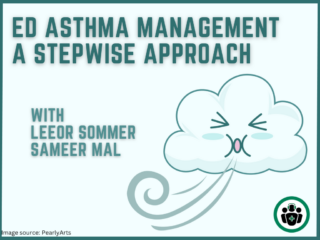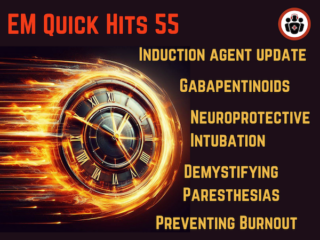Most Recent
EM Quick Hits 56 – Nitroglycerin in SCAPE, REBOA, Diverticulitis Imaging, CRAO, Penicillin Allergy, Physician Personality
In this month's EM Quick Hits podcast: Justin Morgenstern on the first RCT of high dose nitroglycerin in SCAPE, Andrew Neill on Resuscitative Endovascular Balloon Occlusion of the Aorta (REBOA) indications and evidence, Brit Long on indications for CT in suspected diverticulitis, Tahara Bhate on Central Retinal Artery Occlusion (CRAO) and diagnostic error, Matthew McArthur on penicillin allergy labels, myths and penicillin challenges, and Susan Lu on how ED physician personality influences patient outcomes...
Ep 193 The Crashing Asthmatic – Recognition and Management of Life Threatening Asthma
In this part 2 of our 2-part podcast on asthma with Dr. Sameer Mal and Dr. Leeor Sommer, we dig into the recognition and management of life-threatening asthma. We answer such questions as: what are the key elements in recognition of threatening asthma? What are the most time-sensitive interventions required to break the vicious cycle of asthma? What are the best options for dosing and administering magnesium sulphate, epinephrine, fentanyl and ketamine in the management of the crashing asthmatic? What is the role of NIPPV in the management of life-threatening asthma? What are the factors we should consider when it comes to indications for endotracheal intubation of the crashing asthmatic? What role do blood gases play in the decision to intubate? What are the most appropriate ventilation strategies in the intubated asthma patient? and many more... Please support EM Cases with a donation: https://emergencymedicinecases.com/donation/
ECG Cases 49 – ECG and POCUS for Dyspnea and Chest Pain
In this ECG Cases blog, Jesse McLaren and Rajiv Thavanathan explore how ECG and POCUS complement each other for patients presenting to the emergency department with shortness of breath or chest pain. They explain complementary diagnostic insights into pericardial effusion and cardiac tamponade, occlusion MI and RV strain...
Ep 192 ED Adult Asthma Management Strategies For Improved Prognosis – A Stepwise Approach
In this part 1 of our 2-part podcast series on Asthma Management we explore a systematic approach to managing patients presenting to the ED with asthma exacerbations. Our discussion will emphasize the critical role of a thorough history and physical examination in effectively stratifying patient risk and guiding treatment/disposition decisions. Additionally, we'll examine the importance of providing comprehensive discharge medications and instructions to mitigate both mortality and morbidity associated with asthma exacerbations. We answer questions such as: which patients, if any, require peak expiratory flow measurements in the ED? Why is it so important to add steroid MDI therapy to oral steroid therapy in patients being discharged from the ED after an asthma exacerbation? What are the most predictive variables to risk stratify patients with asthma exacerbations to help guide treatment and disposition? and many more. Stay tuned for Part 2, where we'll delve deep into the management of the crashing asthmatic. Please support EM Cases FOAMed with a donation: https://emergencymedicinecases.com/donation/
WTBS 29 Four Key Learnings from a Career in Emergency Medicine Leadership
In this Waiting to Be Seen blog Dr. Howard Ovens outlines 4 key learnings from his extensive career in EM leadership: Be a good clinician, get substantial real-world experience, take a long-term view of benefits and risks and get along with your counterparts in the leadership dyad...
EM Quick Hits 55 – Induction Agents, Gabapentinoids, Neuroprotective Intubation, Approach to Paresthesias, Preventing Burnout
Anand Swaminathan on an update on the appropriate selection of induction agents. Hans Rosenberg on when to use gabapentinoids for pain control in the ED. Katie Lin on pearls for neuroprotective intubation. Nour Khatib and Hamza Jalal on an approach to paresthesias in the ED. Eric Wortmann on preventing burnout in emergency medicine. Please support EM Cases with a donation https://emergencymedicinecases.com/donation/







